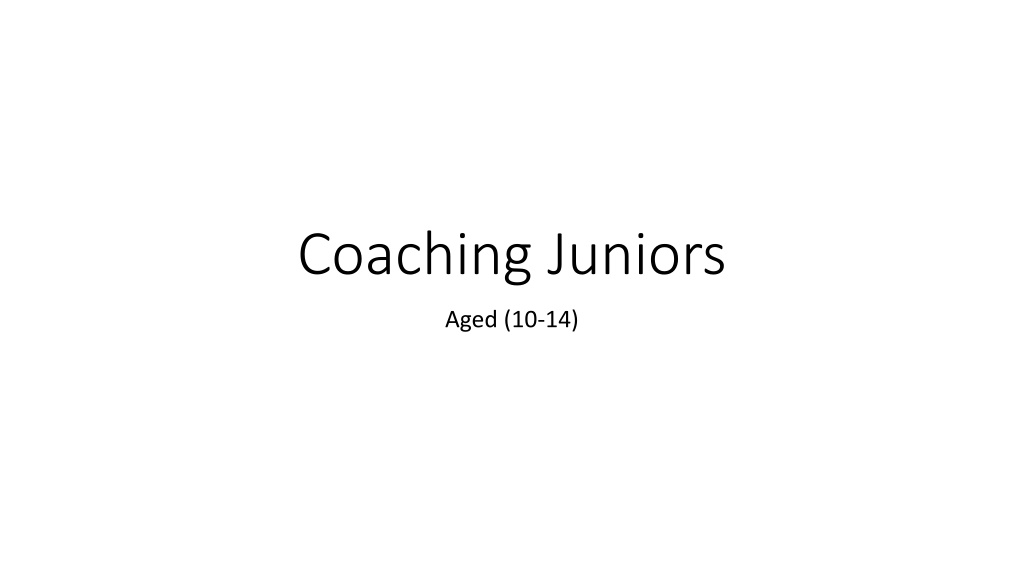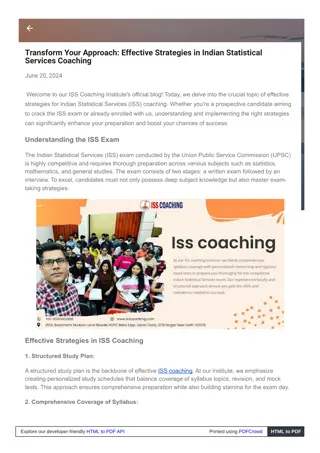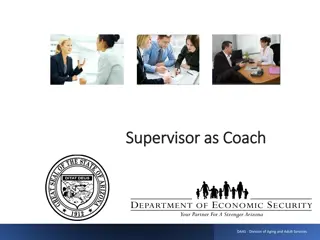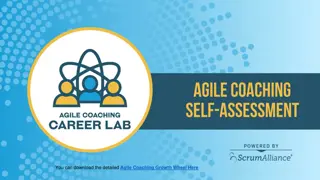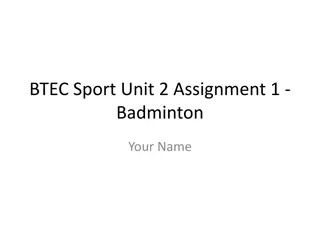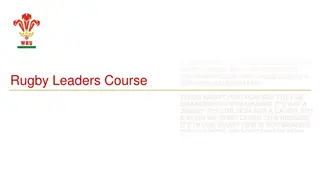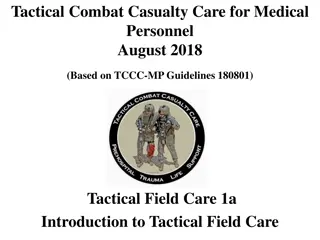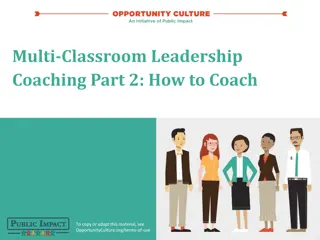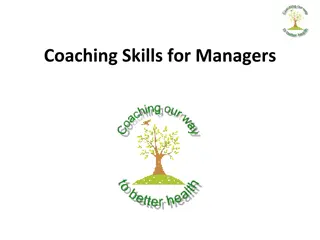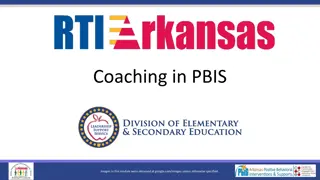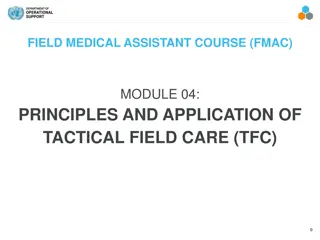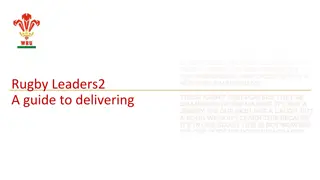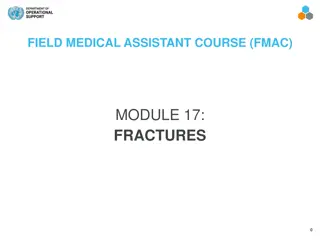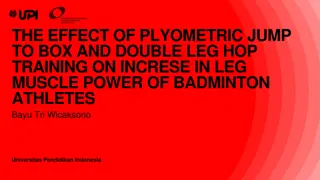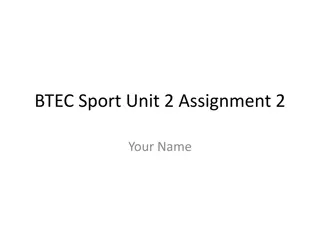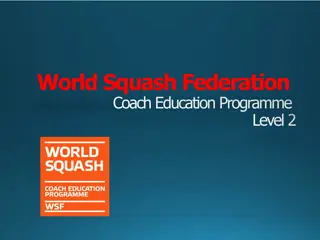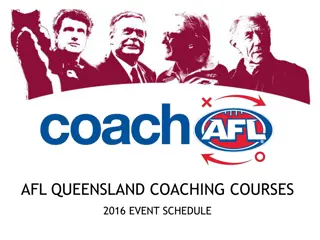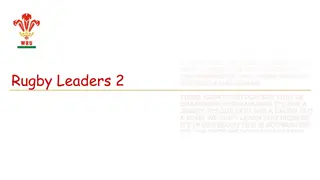Coaching Juniors Aged 10-14: Developing Tactical Awareness in Badminton
Introduction to coaching philosophy for junior players aged 10-14, emphasizing hard work, team work, embracing failure as a learning opportunity, and understanding variables outside of one's control. The course covers topics such as tactical awareness, planning, and technique development. Assumptions about players' skill levels and motivation are outlined, and the importance of developing tactical awareness in junior badminton is highlighted. Types of awareness including spatial, opponent, and personal are discussed, with suggestions for coaches to enhance their own tactical awareness by watching badminton matches online.
Download Presentation

Please find below an Image/Link to download the presentation.
The content on the website is provided AS IS for your information and personal use only. It may not be sold, licensed, or shared on other websites without obtaining consent from the author. Download presentation by click this link. If you encounter any issues during the download, it is possible that the publisher has removed the file from their server.
E N D
Presentation Transcript
Coaching Juniors Aged (10-14)
Introduction Introduction and brief explanation of coaching philosophy Hard Work Team Work Embracing failure (and learning from it) Believing in the process Accepting some variables are outwith your control
Introduction cont. Overview of course and topics which will be discussed 1: Tactical awareness and implication within training 2: Planning 3: Developing technique Questions welcome at any time (I can t promise that I will know the answers)!
Assumptions: Player s have a basic understanding of all strokes and can perform these strokes within unpressurised situations. Player s have an understanding of movement and are confident in linking footwork patterns together. Player s develop at different rates (especially during this period of their lives as puberty is a big factor) Player s are motivated to change and improve!!!
Tactical Awareness Tactics can be seen as the ability to make effective decisions based on an awareness of the situation. (BE) Tactical decision making is the process which the player goes through when deciding which stroke to play. The level of tactical awareness in Junior badminton varies considerably (At U13 level often the strongest player wins as they are able to pin there opponent to the rear court, very rarely does one player dominate an age group from U11-U19, of course there are exceptions) In order to prepare junior players properly for later years within badminton it is vitally important that we help them to develop an understanding of the game from a tactical perspective.
Types of Awareness 5 Types of awareness are defined by BWF AS spatial, personal, opponent, pace and partner. Today we will focus more on the following 3: Spatial awareness (Height, depth and width) Opponent awareness (opponent s position on the court + position within the rally) Personal awareness (own position on the court + position within the rally)
Tactical awareness (Developing our own tactical awareness) As coaches it s important that we continue to develop ourselves in order to help develop the player s. Good place to start is through watching different levels of badminton on YouTube. (YouTube has an option to play video s at 50% or slower speed) U15 European Championships 2018 link: (https://www.youtube.com/results?search_query=badminton+u15+europe an+championship+). BadmintonEurope also have an archive of videos available: https://www.badmintoneurope.tv/en-int/page/archive-badminton-europe When watching individual points try to look for where the point is lost from. At higher levels this can be 4-5 shots before the shuttle hits the ground. Watch individual points 2-3 times and look for a change in the rhythm.
Developing players tactical awareness One of the best ways to do this is through video analysis especially using matches where the level between the player s is quite even. Allow the player to tell you what they see (it s important to understand from their perspective) Guide the player through questioning towards what you are looking for them to see.
Understanding Pressure (and dealing with it) Pressure can easily be explained through using a numbers scale from 0- 100: 100 being maximum pressured applied by the opponent (Heavily defensive position virtually no chance to win the point, with opponent having a clear chance to finish the rally with one shot etc. Net kill) 0 being the polar opposite (Having a clear opportunity to finish the rally with one shot etc. Net kill) I m not so interested in the extreme ends of the scale as from these positions there isn t much anyone can do. Instead I would like to focus on the range between 25-75 where the majority of the strokes are played.
Understanding Pressure cont: In Junior badminton the balance of pressure often shifts very quickly (often from one shot to the next), this is down to a combination of factors: 1. Poor shot selection 2. Imbalance between level of players (physical, playing ability etc) 3. unforced error/ great shot /unexpected reply 4. Failure to increase pressure/ quality of shot In terms of coaching I would like to focus on the first and last points (as these points are within the players control)
Understanding Pressure (Defensive perspective) Very often juniors try to flip the rally (going from a heavily defensive position to winning the point) Normally through playing too flat and cross into the space (show example of Csanad from Europeans 0:40 + 1:07-1:24 + 3:40 END) One of the first words I learned in Hungarian was, egyenes The main issue with this is as they progress through the age groups they often will end up putting themselves under greater pressure. At U11/U13 level players can get away with more due to the size and physically capabilities of their opponents, by U17 this is largely ineffective.
Understanding Pressure (Defensive perspective) Instead of encouraging players when they hit a winning shot, we should look to encourage positive shot selections even when they are not successful. Helping players to understand that when they switch from neutral (50/50) to a defensive position (60/40-70/30) they should like to build their way out and gradually reduce the deficit. Obviously this is not always the case but on the balance of probability they should be more successful at trying to reduce pressure gradually due to the decrease in risk associated with relieving pressure gradually.
Dealing with Pressure Cont: Height and Length are two of the most important factors when looking to decrease pressure. (Show Marci Video) Reminding players when they get put under pressure how they often start a point (with a high serve) Encouraging players to use height and length when they are beginning to be put under pressure. Using a high lift to the rear of the court is the same as starting the point again
Breakdown of court Target area for length, height of stroke is determined through opponents position + amount of pressure individual is under.
Adding pressure (Attacking perspective) On the other end of the scale when juniors are attacking they often try to increase the pressure too quickly (and therefore increase their own risk) As players progress through the age groups more and more strokes will start to be returned. This is a difficult area for the players to understand and they can begin to doubt their own ability (Strokes which were winning strokes at U11/13 now require follow up strokes in order to be successful) As a result they end up waiting for the shuttle and allowing there opponent back into the point. (Show example of Petra from Europeans 0.21)
Tactical awareness Implication within training MOST IMPORTANT factor is players UNDERSTAND what they should focus on!! There are hundreds of variable exercises which can be used, when designing an exercise ensure the focus of the exercise is not lost. Keep exercises simple at the start, juniors can t concentrate on multiple variables straight away, this process has to be slowly implemented into their training. Main purpose is to get player s to begin to think more about there shot selections. In my opinion most of the player s are sub consciously learning how they should construct points. I would like then to gain a clear understanding of how to do this.
Neutral game Within top level singles the majority of the match is played within the middle section of the court (shown later slide). This area is known as the neutral zone. Speed of shot and angles very important here Provided a reasonable angle and length are maintained within this section risk remains relatively low and forces the opponent to either maintain a neutral position or play a higher risk stroke. Although this area is not of vital importance at U11/U13/U15 level it is important to help the players develop an understanding of this area and how to use it effectively in a game.
Breakdown of court Higher risk areas. Main advantages: Winning strokes are more likely in these areas. Main disadvantage: Gives chance for opponent to create angle. Increased risk of error.
Everything to the front T exercise This exercise can be started using Multi-shuttle and progressed onto single shuttle Eventually this should be progressed to a single shuttle routine where the feeder should focus on: Moving the worker around the court in order to increase the pressure Putting pressure on worker through taking the shuttle early Worker is focusing on: Maintaining low recovery position and trying to explode towards the shuttle in order to try and maintain/decrease level of pressure on them Grip changes when put under pressure in the rear court in order to maintain net level
Everything to front T Target area: Important that feeder works from base when progressed to single shuttle.
Everything to front T (attacking option) exercise Feeder should give some opportunities for players to take attacking initiative Worker is working on their own decision making (to begin with Feeder should make it quite obvious when worker should look to attack Progress exercise over time to the point where the difference isn t easily noticeable and eventually to the point where the worker is battling with the feeder in order to create the chance for themselves.
Everything to front T (with attacking options) Front court yellow: Give chance to spin. Rear court yellow: Give more height to encourage attack
Everything to backline Exercise can again be started off using multi shuttle and then progressed to the point of single shuttle. Use patterned exercises to begin with (before progressing to include variables for the feeder) when moving to single shuttle Example (2 Clears and 1 drop from the feeder, progress to allowing straight and cross clears and straight and cross drops Important to remember that player s are often not strong enough to hit full length when under pressure at the rear court Encourage players to use height at the front court to give themselves time
Everything behind the Front T (Only 1 player can play cross) This is a more advanced routine which works on player s decision making. Player who has the option to cross should maintain an attacking position within the rally as they are predominately covering 2 corners Player who can only play straight should try to maintain position within the rally and counter when playing cross Player who has the option to cross should wait for the correct time to cross (this can be turned into a conditioned game where the player playing cross can loss/gain extra points from winning/losing with a cross stroke)
Planning In order to prepare player s properly it is important that you set out a plan in terms of their develop. In my opinion this is extremely difficult to do when working within a group as the plan must be wide enough to cover a range of abilities. The best type of plan is individually based however this is impossible to do when working with 20 plus juniors. Use GOAL setting when designing a plan.
GOALS This is something that everybody here uses even if they don t realise it. If you have attempted to help a player improve, through developing a stroke or teaching something new then the chances are you have used GOAL setting. BWF recommend we use the following questioning when GOAL setting Where are we now? Where do we want to be (in a specified period of time)? How are we going to get there?
Planning for Juniors Once you have set out what you would like to achieve then its down to working out how you are going to get there. I would suggest using Yearly planning for junior players (GOALS should be broadly used so as to encompass everyone in the group) Example: Could be, by the end of this 6 week training block I would like players to be able to play a full length lift from a 2 shot combination 7/10 times. Although you will be working on a plan for a 1 year period it s important to think about the future of the player Plans should be based around the process of developing players for the future. (We are NOT trying to create the finished article in a 1 year period!) Instead we should look to focus on developing technique, footwork patterns and a tactical understanding of the game. Parents and often players want to win NOW, in my opinion it s not important to be the best at U11/13/15 level, (development and winning are not always intrinsically linked)
Planning for Juniors cont. Bwf have some example templates used within their coaching resources. https://development.bwfbadminton.com/wp- content/uploads/2016/08/BWF_Coach_Manual_Level_2_English.pdf page 29 has a yearly plan example. Keep THE PLAN SIMPLE (and remember it s ONLY a plan) (Example of yearly plan)
Developing Technique and footwork Technique is a huge area within badminton. This area covers everything from preparation, to striking action and follow through + recovery. Key points: Remember they are children, they can t take in the same amount of information as you. Try to look at all sections of the stroke; preparation, hitting action and recovery. Remember to look at the whole picture as the issue can arise from the footwork or recovery action which then impacts on the hit. Keep feedback clear and short, give the players 1 or 2 points to focus on when developing technique. (Don t deviate too far from these points) Everybody is different, we aren t trying to make everyone look the exact same. When trying to alter technique consider the reasoning behind the alteration.
Why do we need to change the Technique? When trying to alter the technique of a particular stroke consider the following: (lets consider forehand rear court attack as an example) Can the player play all strokes from this position (do they use different grips to play different strokes)? How do they move to the shuttle? Are they getting behind it and recovering when hitting? Is the preparation similar for each stroke (common problem is player s loading up their arm when smashing)? Would altering the technique make a difference to the outcome of the shot (decrease the risk of error, making strokes more deceptive, increase power etc)? Does the player have the capacity to realistically change? (Common problem can be with using a palm handled grip, if a players has been using this for years this can be difficult to change)
How do we change Technique PATIENCE!!!!!!!!
How do we change Technique Reassure the player, ensure they understand that they may get worse before they get better. Praise the process and avoid focusing on the outcome (especially at the start of changing technique as they will often hit a poorer quality of shot) Progress the technique gradually and methodologically, ensure quality is what your looking for before moving on (of course it s ok to jump from a 2 shot combination to a conditioned game in order to increase the intensity within a session, however as coaches we can t expect the player to reproduce the same quality)
Developing/changing technique Once you have identified the area you would like to focus on, it s down to working out how you are going to take the player from where they are to where you want them to be.
Developing technique exercises Begin with Multi Shuttle work, working only on 1 corner (good place to start is with lifts) Gradually increasing the pressure on the worker over time Progress to 2 shot combinations where the worker knows where both shots will come Example: Forehand pull + backhand lift . 2 shot combinations with 1st stroke random (Multi > Single) Example: Any rear court stroke followed by backhand lift 2 shot combinations with 2nd stroke random (Multi > Single) Example: Forehand pull followed by any lift.
Exercise Progressions 3 shot combinations with 2nd shot random (Multi > Single) Example: Forehand pull, any lift then straight block 3 shot combination with 3rd shot random (Multi > Single) Example: Forehand pull, Forehand lift then any shot 3 shot combination with 2nd + 3rd shot random (Multi > Single) Example: Forehand pull, any lift then anywhere Important point when doing these types of exercises is to vary the practice (children need to be challenged but the focus of the exercise should remain, find the balance), don t be worried to progress too far and then having to take a few steps back.
Single shuttle progression Single shuttle routine with no variables Example: Clear, Clear, drop, net, lift (with focus being in length of Clears and lifts) Single shuttle routine with 1 variable (then 2 variables etc) Example: Clear, Clear or drop, (drop), net, lift Single shuttle routine with attacking variable (bring in decision making) Example: Clear, Clear, drop, net, lift (Either playing can smash if the length is short, if player smashes block, net and lift and start again) Example can be progressed to allow player smashing to follow up with a net kill Conditioned game: This should be related to the focus point Example: Clear, Clear, drop, net, lift (Either player can attack if the length is short, If they play a winner from this then they score extra points, if they lose from this situation then they lose extra points.
Developing footwork Footwork should be developed alongside technique (as in a match they will need to hit a shot in a match after completing the footwork) Footwork can be developed through shadow however it s important that the shadow is of high quality (game like speed) Once the player understands the steps this can be added into the progressions previously mentioned in order to create more pressure.
